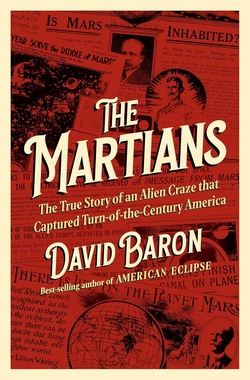Centauri Dreams
Imagining and Planning Interstellar Exploration
Ryugu’s Clues to the Early Solar System
Asteroid 162173 Ryugu, recently explored in depth by the Hayabusa2 spacecraft, is a C-type asteroid, rich in carbon. About a kilometer in diameter, it is evidently composed of highly porous material, and seems to have been formed by the agglomeration of fragments from a larger parent body that was broken apart by impacts. We learn this from a new paper in Nature that examines the object’s high porosity and the significantly low mechanical strength of its rock fragments, which affect how it would act if hitting an atmosphere.
Matthias Grott, of the German Aerospace Center (Deutsches Zentrum für Luft- und Raumfahrt; DLR) is the principal investigator for MARA, the DLR-built radiometer that flew on board Hayabusa2 and landed aboard the Mobile Asteroid Surface Scout (MASCOT). Says Grott:
“The published results are a confirmation of the results from the studies by the DLR radiometer MARA… It has now been shown that the rock analysed by MARA is typical for the entire surface of the asteroid. This also confirms that fragments of the common C-type asteroids like Ryugu probably break up easily due to low internal strength when entering Earth’s atmosphere.”
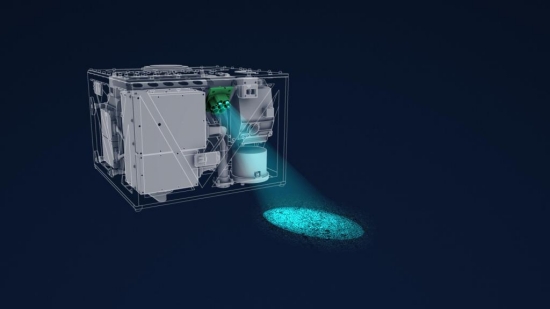
Image: An artist’s conception of the MARA radiometer at work within MASCOT on the surface of Ryugu. Credit: DLR.
Breaking up into fragments upon entering Earth’s atmosphere would help to explain why carbon-rich meteorites are relatively uncommon on Earth, as most would have burned up on the way to the ground. But the new paper goes on to make the case that fragile, porous asteroids like this may link us directly to the evolution of primordial dust into planetary bodies. Hence the importance of missions like Hayabusa2 and OSIRIS-REx, which actually visit and sample the minor objects that would have formed during the earliest era of the Solar System’s development.
The paper in Nature looks at the global properties of Ryugu, an analysis that complements and confirms the findings of the MASCOT lander. The asteroid’s surface temperature has been examined through the Thermal Infrared Imager (TIR) aboard the spacecraft by the team working with first author Tatsuaki Okada of the Japanese space agency JAXA. Measuring in the 8 to 12 micrometer wavelength range during day and night cycles, they find a surface that heats quickly when exposed to sunlight. Grott adds:
“The rapid warming after sunrise, from approximately minus 43 degrees Celsius to plus 27 degrees Celsius suggests that the constituent pieces of the asteroid have both low density and high porosity.”
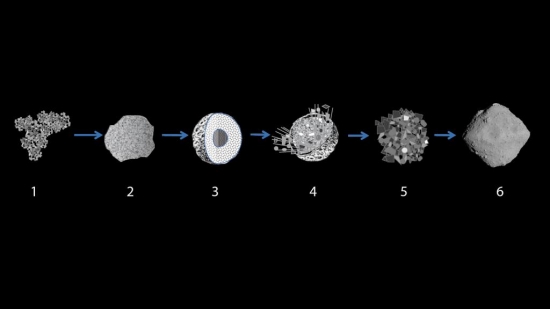
Image: Formation scenario for Ryugu. Credit: Okada et al.
We should be learning a lot more when the surface samples from two landing sites, currently traveling back to Earth with the spacecraft, land in Australia at the end of this year. The paper draws not only on already acquired surface data but high resolution mapping from orbit. The authors argue that C-type asteroids are most likely formed from ‘fluffy dust’ or pebbles in the early Solar System, leading to large asteroids in the main belt with high porosity. Further thoughts re planet formation from the paper:
These C-type asteroids might share their highly porous nature with planetesimals that formed from fluffy dust in the early Solar System and could have strongly affected planetary formation processes such as cratering and collisional fragmentation by attenuating shock propagation . The possibility still cannot be ruled out that Ryugu’s low thermal inertia and low density arise from surface materials different from carbonaceous chondrites, such as the organic- rich material discovered on comet 67P/Churymov-Gerasimenko . This question will, however, be resolved upon sample return.
What the samples will reveal, then, is whether Ryugu is made up of material similar to chondritic meteorites — chondrules are millimeter-sized spheres of rock considered to be building blocks of planet formation — or organic-rich material like that found on comet 67P/ Churyumov-Gerasimenko. We’ll have that answer comparatively soon, but there is something else to look forward to when it comes to probing exotic materials: The sample returns from the OSIRIS-REx mission at asteroid Bennu, expected in 2023, and samples of Phobos and Deimos. The latter should reach us in 2029 as JAXA explores the asteroid-like Martian moons in the ‘Martian Moons eXploration’ (MMX) mission, scheduled for launch in 2024.
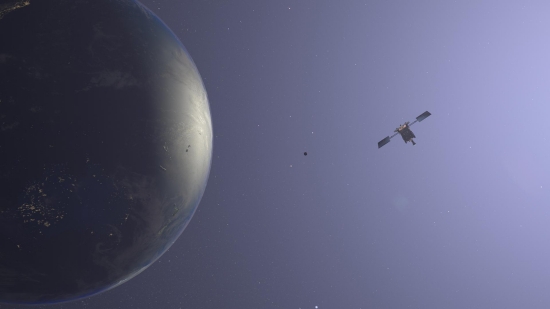
Image: Artist’s conception of Hayabusa2 nearing the Earth for sample return. Credit: DLR.
The paper is Okada et al., “Highly porous nature of a primitive asteroid revealed by thermal imaging,” published online by Nature 16 March 2020 (abstract).

Extending the Hunt for Trans-Neptunian Objects
316 Trans-Neptunian Objects (TNOs) have turned up in a new analysis of data from the Dark Energy Survey, 139 of these being new objects that have not been previously published in the literature. With roughly 3,000 TNOs known, the catalog from this work represents a healthy 10 percent of the total, but more significantly, extends and fine-tunes our methods for tracking such objects.
Trans-Neptunian Objects, of which Pluto/Charon represents the best known, orbit beyond Neptune, with Kuiper Belt Objects being a sub-category existing between 30 and 55 AU from the Sun. Here the population is thought to be in the tens of thousands when restricting the definition by size to objects at least 100 kilometers across. But to these Kuiper Belt objects we can add the population of so-called Scattered Disk Objects, which exist in eccentric and inclined orbits, the more extreme of these with semi-major axes between 150 and 250 AU (and then there’s Sedna, with aphelion now estimated at more than 900 AU).
Carly Howett’s excellent overview of TNOs from the Southwest Research Institute (Boulder, CO) explains their wide-range and is highly recommended. For now, let’s focus on the DES dataset and the catalog that is growing out of it. The Dark Energy Survey wasn’t created to be a hunter of minor planets but rather an attempt to map hundreds of millions of galaxies while detecting supernovae in the thousands, the idea being to find patterns of cosmic structure that may give us insights into the ‘dark energy’ that seems to be accelerating the universe’s expansion.
DES is an international effort, with over 400 scientists from 25 institutions around the world using data collected by a highly sensitive 570-megapixel digital camera called DECam that is mounted on the Blanco 4-meter telescope at Cerro Tololo Inter-American Observatory in the Chilean Andes. Between 2013 and January of 2020, the collaboration carried out a wide-area survey, imaging 5000 square degrees of the southern sky in five optical filters.
Out of these high precision images came the opportunity seized by the University of Pennsylvania researchers to search for new objects beyond Neptune. University of Pennsylvania graduate student Pedro Bernardinelli, lead author of the paper on this work, saw the opportunity presented by the DES dataset:
“Dedicated TNO surveys have a way of seeing the object move, and it’s easy to track them down. One of the key things we did in this paper was figure out a way to recover those movements [in the DES dataset].”
Exactly so. What Bernardinelli and team had to construct was a methodology that could tackle deep-sky DES data and apply them to the TNO question. Unlike DES, TNO surveys generally take measurements as frequently as hourly, allowing astronomers to track object movements against the background field. Adapting DES data was a challenge. Working with the first four years of the DES images, Bernardinelli extracted an initial dataset of 7 billion ‘dots’ that represented objects detected by his software above the background levels of the images.
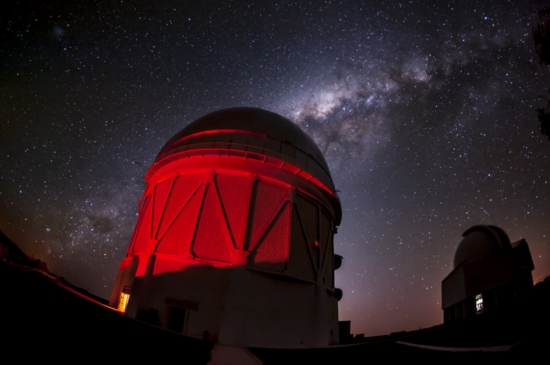
Image: The Blanco Telescope dome at the Cerro Tololo Inter-American Observatory in Chile, where the Dark Energy Camera used for the recently completed Dark Energy Survey was housed. Credit: Reidar Hahn, Fermilab.
The researcher was able to build a ‘transient’ list of 22 million objects by culling out stars, galaxies and supernovae; he then began looking for movement on successive nights. 400 candidates emerged out of the 22 million-object field, all of them seen over at least six nights of observation and subsequently subjected to filtering and verification. The latter involved going back to the original dataset to see if more images of the object in question could be located.
Previously known TNOs were likewise useful, their location examined for 25 different nights as the researchers gathered information that helped them adjust their models. Stacking multiple images helped to confirm an object’s TNO status, while injecting fake objects into the analysis served as a check on how the methods handled them. The 316 TNOs isolated by this period of development and analysis revealed objects from 30 to 90 times Earth’s distance from the Sun.
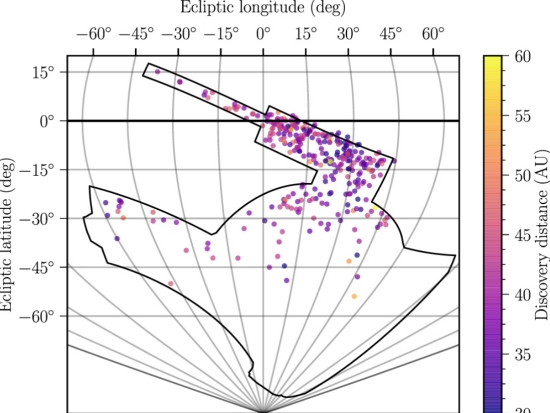
Image: The location of the objects found in the first four years of DES data. The outline shows DES’s search range and the color of each dot shows how far away the object is in astronomical units. Two of the detections were more than 90 AU, or almost 13 billion kilometers away. Credit: Pedro Bernardinelli.
Ahead for this team is an analysis incorporating the last two years of the DES dataset, with a lower threshold for object detection at the first filtering stage. As many as 500 new TNOs, the researchers estimate, may turn up in this work. The hope is that the programs the team has developed will now be useful when applied to other large datasets in the future. Remember that the orbits of the various categories of TNO help us to analyze as yet unseen objects beyond Pluto’s orbit that may include the hypothesized ‘Planet Nine,’ so the more TNOs, the better.
The paper is Bernardinelli et al., “Trans-Neptunian Objects Found in the First Four Years of the Dark Energy Survey,” The Astrophysical Journal Supplement Series Vol. 247, No. 1 (10 March 2020). Abstract.

An Unusual Look at Mercury
Centauri Dreams rarely looks at Mercury, the operative method being generally to focus on the outer Solar System and beyond. But a new paper out of the Planetary Science Institute in Tucson (AZ) raises the eyebrows in suggesting that parts of Mercury may once have been able to shelter prebiotic chemistry and perhaps, according to the authors, even primitive life forms. Such a finding might thus extend our ideas of ‘habitable zones’ much closer to parent stars than previously assumed.
It seems a long shot, given surface temperatures reaching 430? in the daytime and -180? at night, but the PSI work turns up interesting possibilities in some subsurface regions of Mercury. The heart of this research is found in the datasets returned by the MESSENGER (MErcury Surface Space ENvironment GEochemistry and Ranging) spacecraft. The Mercury orbiter identified numerous volatile-bearing surfaces on Mercury, with high abundances of sulfur, chlorine and potassium, and polar ice in permanently shadowed craters at the planet’s poles.
Key to the research are Mercury’s ‘chaotic’ terrains, hilly and fractured areas first seen in 1974 in the flybys of Mariner 10. The planet’s spectacular Caloris Basin is a crater about 1525 kilometers across ringed by mile-high mountains. Interestingly, numerous chaotic terrains are found directly on the other side of the planet from the Caloris Basin, leading to the theory that the impact produced them. The new paper finds that idea unconvincing. Instead, the chaotic terrains seem to have formed through gradual developments of a non-catastrophic nature. From the paper:
We attribute the immense volume losses, which we infer to have occurred during chaotic terrain formation… to widespread collapse associated with the devolatilization of hundreds of meters to a few kilometers of upper crustal materials. In the context of this hypothesis, we define “collapse” as encompassing elevation losses due to (1) mass wasting associated with the sublimation of surface/near-surface volatiles and (2) gravity-driven terrain disintegration over zones of deep volatile evacuation.
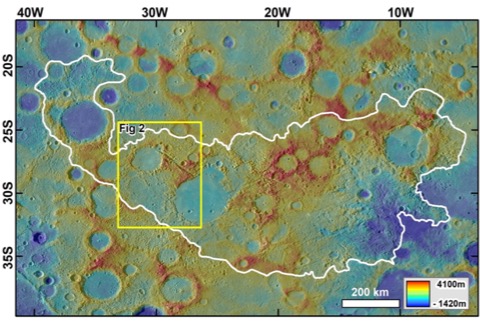
Image: Extent of a vast chaotic terrain (white outline) at the antipode of the Caloris basin (~5 x 105 km2). Credit: Rodriguez et al.
In other words, no impact needed. The authors note that the chaotic terrain is not geographically limited to the Caloris antipode, suggesting that the volatile-rich crust may have been global. They also find that the antipodal area experienced an active phase about 1.8 billion years ago for reasons unknown. The paper identifies large areas of surface elevation losses within the antipodal chaotic terrains, a finding the authors interpret as the result of crustal volatiles turning into gas and escaping from Mercury’s upper crust over an area of about 500,000 square kilometers.
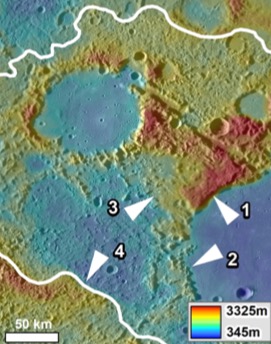
Daniel Berman (Planetary Science Institute) is a co-author of the paper:
“The deep valleys and enormous mountains that now characterize the chaotic terrains were once part of volatile-rich geologic deposits a few kilometers deep, and do not consist of ancient cratered surfaces that were seismically disturbed due to the formation of Mercury’s Caloris impact basin on the opposite side of the planet, as some scientists had speculated. A key to the discovery was the finding that the development of the chaotic terrains persisted until approximately 1.8 billion years ago, 2 billion years after the Caloris basin formed.”
Image: Zoom in showing variable magnitudes of collapse, which includes a relatively unmodified rim section that is smooth but not broken into knobs (arrow 1). This area adjoins another part of the rim that has been almost entirely removed (arrow 2). The adjacent intercrater regions also exhibit deep and abrupt relief losses (arrows 3 & 4). Credit: Rodriguez et al.
Where did this volatile-rich crust come from? One possibility is impacts from outer Solar System objects or perhaps main belt asteroids. Another is outgassing of volatiles from the interior. PSI’s Jeff Kargel, likewise a co-author, makes this interesting point:
“We also observe evidence of surficial devolatilization, probably caused by solar heating. If so, we have an opportunity to infer the range of Mercury’s volatile properties and compositions… While not all volatiles make for habitability, water ice can if temperatures are right. Some of Mercury’s other volatiles may have added to the characteristics of a former aqueous niche. Even if habitable conditions existed only briefly, relics of prebiotic chemistry or rudimentary life still might exist in the chaotic terrains.”
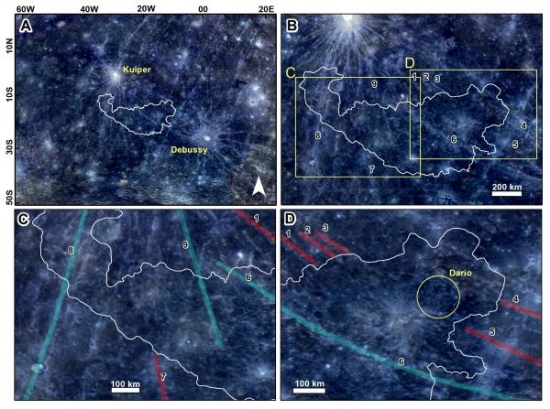
Image: Context view showing the location and extent of the chaotic terrain antipodal to the Caloris basin (outlined in white) relative to the ray systems of the Kuiper and Debussy impact craters. (B) Close-up view of panel A that provides the context and locations for panels C and D. The numbers 1-9 identify individual rays within the region’s view. (C, D) Close-up view showing crater rays that extend over the chaotic terrain (green lines 6, 8, 9) and other crater rays that appear truncated over the chaotic terrain (red lines 1-5, 7). We provide the location of the hollow hosting crater Dario in panel C. Credit: Rodriguez et al.
That volatile losses may not all be ancient is inferred from the fact that crater ejecta rays are not found in extensive areas of the chaotic terrain, which the authors interpret as indicating more recent activity. Mercury’s ‘hollows’ — small depressions resembling melt pits in terrestrial permafrost — have likewise been investigated as signs of near-surface volatile losses, although the matter is still under investigation. Whatever the case, it’s apparent that MESSENGER has returned enough information to offer up a first round of potential landing sites to investigate the planet’s volatile-rich crust and conceivably study its unexplored potential for astrobiology.
The paper is Rodriguez et al., “The Chaotic Terrains of Mercury Reveal a History of Planetary Volatile Retention and Loss in the Innermost Solar System,” Scientific Reports 10, Article number: 4737 (2020). Full text.

Exoplanet Climatology: Surprising Find from ESPRESSO
Learning about the climate on exoplanets is not something that the designers of ESPRESSO had in mind. Installed at the European Southern Observatory’s Very Large Telescope at Paranal (Chile), the Echelle SPectrograph for Rocky Exoplanet and Stable Spectroscopic Observations combines the light of the four VLT telescopes, making it a powerful instrument indeed. We have what is in effect a 16-meter telescope that really ramps up the capability of radial velocity methods.
But climate? The case in point is WASP-76b, some 390 light years away in Pisces. So much of the excitement surrounding ESPRESSO has been its ability to drill down to detect small, rocky exoplanets, but this world is somewhere near Jupiter mass, considerably larger in radius, and hellishly close to its star, an F7-class object about 1.5 times as massive as the Sun. The planet orbits the star every 1.8 days at an orbital distance of 0.03 AU and appears to be tidally locked.
The result: Temperatures in the area of 2,400° C, breaking molecules apart and causing metals to evaporate. Throw in a dark-side temperature of about 1,500° C and you’ve got an incubator for extreme winds carrying iron vapor into the nightside, where it precipitates as what we might call an iron rain. This is more than conjecture, as ESPRESSO is powerful enough to detect a strong iron vapor signature at the edge of this planet’s ‘evening,’ with no such signature on the other side.
Says Christope Lovis (University of Geneva):
“Surprisingly… we don’t see iron vapour on the other side of the planet, in the morning. The conclusion is that the iron has condensed during the night. In other words, it rains iron on the night side of this extreme exoplanet.”
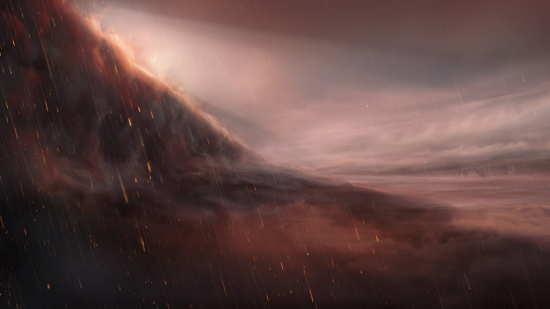
Image: WASP-76b’s showers appear to consist of iron raindrops, as seen in this illustration. Credit: M. Kornmesser/ESO.
ESPRESSO is just coming into its own. First light occurred in 2017, and the WASP-76b work draws on the first scientific observations made with the instrument in September of 2018. We’re beginning to see that this spectrograph has unusual potential, as principal investigator Francesco Pepe notes:
“We thought very early on that we could use the instrument not only to discover new planets, but also to characterize those that are already known. However, until 2018, we didn’t realise how powerful ESPRESSO really was in this field.”
Climatology on extreme planets makes that case, and we can assume WASP-76b is only the first such investigation. Meanwhile, we continue to witness the ever increasing power of radial velocity methods, which measure tiny variations in the Doppler signature of stars as they are pulled back and forth by the planetary systems around them.
Transiting worlds have been of crucial assistance as we have built up the exoplanet catalog, but radial velocity can measure planets that do not cross the face of their star as seen from Earth. Moving beyond detection levels of 1 meter per second, the new goal is 10 centimeters per second and below, a radial velocity precision sufficient to detect an Earth-mass planet in the habitable zone of a small star.
The paper is Ehrenreich et al., “Nightside condensation of iron in an ultrahot giant exoplanet,” published online by Nature 11 March 2020 (abstract).
And we should note this, from the journal: “This is an unedited manuscript that has been accepted for publication. Nature Research are providing this early version of the manuscript as a service to our customers. The manuscript will undergo copyediting, typesetting and a proof review before it is published in its final form. Please note that during the production process errors may be discovered which could affect the content, and all legal disclaimers apply.”
In the era of easily available preprints, we always have to keep in mind the consequences of authorial and editorial changes later in the process. These can sometimes be significant.

A Rare Brown Dwarf Eclipsing Binary
The SPECULOOS-South Observatory at Cerro Paranal, Chile houses four 1-meter robotic telescopes, now deployed in the service of identifying rocky planets transiting low-mass stars and brown dwarfs. Acronym untanglement: SPECULOOS stands for Search for habitable Planets EClipsing ULtra-cOOl Stars. An early success here is the just reported discovery of a triple brown dwarf system, with an inner binary that is eclipsing and a widely separated brown dwarf companion. The inner binary is what is known as a double-lined system, meaning that spectral lines from both eclipsing stars are visible in the data.
Data from the W. M. Keck Observatoy (Maunakea) and the 8-meter Very Large Telescope (VLT), each equipped with sensitive spectrometers, were used to confirm the discovery. Yesterday we saw how the analysis of a young exoplanet, DS Tuc Ab, could offer insights into how ‘hot Neptunes’ form. In a similar way, the brown dwarf triple system 2M1510A fills a needed gap in our data. A member of a 45 million year old moving group, the age of the system matches up with some currently imaged exoplanets, so we have another look at evolutionary models, this time of brown dwarfs, that may also be useful in the study of young planets.
This is also a rare find, as there is only one double-line eclipsing brown dwarf binary known — I’ll mercifully shorten its name to 2M0535 — but it’s so young (part of the 1 million year old Orion Nebular Cluster) that it’s difficult to work into current evolutionary models. The new triple system 2M1510, in which we can identify the mass and radius of the inner binary stars, will be a useful tool. As the authors of the paper on this work note: “The system’s age matches those of currently known directly imaged exoplanets so 2M1510A provides an opportunity to benchmark evolutionary models of brown dwarfs and young planets.”
Amaury Triaud (University of Birmingham, UK) is lead author of the study, which has just appeared in Nature Astronomy:
“Collecting a combination of mass, radius, and age is really rare for a star, let alone for a brown dwarf. Usually one or more of these measurements is missing. By drawing all these elements together, we were able to verify theoretical models for how brown dwarfs cool, models which are over 30 years old. We found the models match remarkably well with the observations, a testament to human ingenuity.”
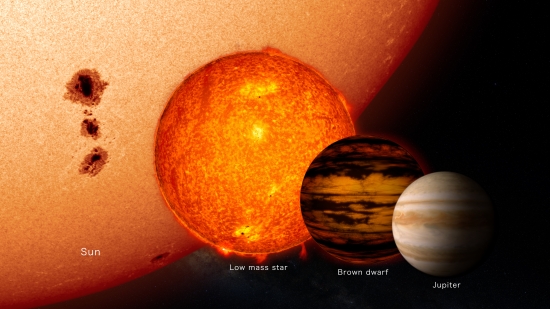
Image: This illustration shows the average brown dwarf is much smaller than our sun and low mass stars and only slightly larger than the planet Jupiter. Credit: NASA Goddard Space Flight Center.
I was startled to find that six other brown dwarf triple systems have been identified, but 2M1510 is the only one with three components that are of approximately the same mass, Moreover, the separation ratio between the inner and outer orbits is the smallest of all the young triple brown dwarf systems yet found. As so-called ‘failed stars,’ brown dwarfs are in the murky region between star and giant planet, unable to sustain hydrogen fusion, but as far as we know forming like stars. We can consider them a key link between star and planet formation.
Brown dwarfs cool as they age, which reduces their radius as well as their luminosity. Young exoplanets do the same, making the two evolutionary models interesting to compare. That makes systems where we can get accurate mass, radius and age determinations crucial, which is why this is a helpful discovery. The authors explain what 2M1510 has revealed:
We find that widely used evolutionary models do reproduce the mass, radius and age of the binary components remarkably well, but overestimate their luminosity by up to 0.65 magnitudes, which could result in underestimations of 20% to 35% of photometric masses for directly imaged exoplanets and young-field brown dwarfs.
I suppose nothing elevated interest in planets around low-mass stars more than the seven small worlds around the TRAPPIST-1 system, in which the primary is an ultra-cool red dwarf star. Close-in rocky worlds around brown dwarfs are likewise a possibility, given that we’ve already identified planets at the brown dwarfs 2M1207, 2MASS J044144, and MOA-2007-BLG-192L, with the latter being roughly 3.3 Earth masses (this one was detected by gravitational microlensing, and is the smallest exoplanet I know of around a brown dwarf). But as we’re seeing, the usefulness of brown dwarfs in planet formation models is another reason that interest in these dim objects is intensifying.
The paper is Triaud et al., “An eclipsing substellar binary in a young triple system discovered by SPECULOOS,” Nature Astronomy 9 March 2020 (abstract).

Where Do ‘Hot Neptunes’ Come From?
Learning about the orbital tilt of a distant exoplanet may help us understand how young planets evolve, and especially how they interact with both their star and other nearby planets. Thus the question of ‘hot Neptunes’ and the mechanisms that put them in place.The issue has been under study since 2004. Are we looking at planets laden with frozen ices that have somehow migrated to the inner system, or are these worlds that formed in place, so that their heavy elements are highly refractory materials that can withstand high disk temperatures?
Among the exoplanets that can give us guidance here is DS Tuc Ab, discovered in 2019 in data from the TESS mission (Transiting Exoplanet Survey Satellite). Here we have a young world whose host is conveniently part of the 45 million year old Tucana-Horologium moving group (allowing us to establish its age), a planet within a binary system in the constellation Tucana. The binary stars are a G-class and K-class star, with DS Tuc Ab orbiting the G-class primary.
A team at the Center for Astrophysics | Harvard & Smithsonian has developed a new modeling tool that is described in a paper to be published in The Astrophysical Journal Letters, one that allows them to measure the orbital tilt of DS Tuc Ab, the first time the tilt of a planet this young has been determined. Systems evolve over billions of years, making analysis of the formation and orbital configuration of their planets difficult. It’s clear from the team’s work that DS Tuc Ab did not, in the words of the CfA’s George Zhou, “get flung into its star system. That opens up many other possibilities for other, similar young exoplanets…”
The work was complicated by the fact that the host star, DS Tuc A, was covered up to 40% in star spots. David Latham (CfA) describes the situation:
“We had to infer how many spots there were, their size, and their color. Each time we’d add a star spot, we’d check its consistency with everything we already knew about the planet. As TESS finds more young stars like DS Tuc A, where the shadow of a transiting planet is hidden by variations due to star spots, this new technique for uncovering the signal of the planet will lead to a better understanding of the early history of planets in their infancy.”
The work proceeded using the Planet Finder Spectrograph on the Magellan Clay Telescope at Las Campanas Observatory in Chile, with the goal of finding out whether this newly formed world had experienced chaotic interactions in its past that could account for its current orbital position. The analysis involved modeling how the planet blocked light across the surface of the star, folding in the team’s projections of how the star spots changed the stellar light emitted. A well-aligned orbit would block an equal amount of light as the planet passed across the star’s surface. The method should aid the study of other young ‘hot Neptunes.’
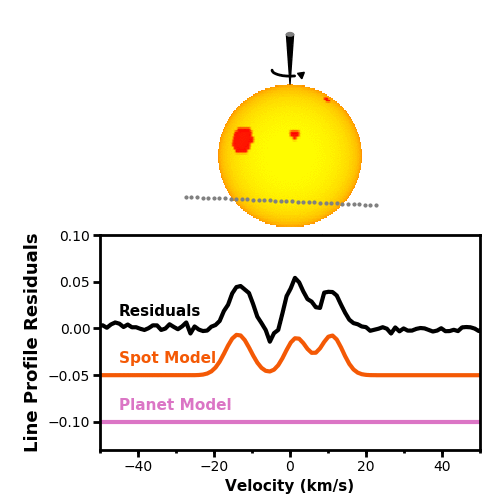
Image: Animation courtesy of George Zhou, CfA. Top right illustration of DS Tuc AB by M Weiss, CfA.
Benjamin Montet (University of New South Wales) is lead author of a companion paper on which the CfA team were co-authors (citation below). Montet’s team used a different technique called the Rossiter-McLauglin effect to study the planet. Here the researchers measure slight blueshifts and redshifts in the star’s spectrum while simultaneously modeling both transit and stellar activity signals. Says Montet;
“DS Tuc Ab is at an interesting age. We can see the planet, but we thought it was still too young for the orbit of other distant stars to manipulate its path.”
What the combined work suggests is that DS Tuc Ab, because of its youth, probably did not form further out and migrate in. Its flat orbital tilt also indicates that the second star in the binary did not produce interactions that pulled it into its current position. The authors of the Montet paper consider this work “a first data point” in an analysis that may eventually confirm or rule out the hypothesis that wide binary companions can tilt protoplanetary disks to produce high inclination orbits in the planets that form within them.
A good deal of work is ahead to understand such young systems, but the methods the Montet team used are promising, for the Rossier-McLaughlin (R-M) effect proves to be potent. From the already published companion paper:
DS Tuc Ab is one of a small number of planets to be confirmed by a detection of its R-M signal rather than its spectroscopic orbit. This approach may be the optimal strategy for future confirmation of young planets orbiting rapidly-rotating stars. While the RV [radial velocity] of the star varies on rotational period timescales at the 300 m s?1 level, it does so relatively smoothly over transit timescales, enabling us to cleanly disentangle the stellar and planetary signals. While this planet would require a dedicated series of many spectra and a detailed data-driven analysis to measure a spectroscopic orbit, the R-M signal is visible by eye in observations from a single night. For certain systems, in addition to a more amenable noise profile, the amplitude of the R-M signal can be larger than the Doppler amplitude. Similar observations to these should be achievable for more young planets as they are discovered, which will shed light onto the end states of planet formation in protoplanetary disks.
So now we’re seeing two complementary methods for studying young planetary systems, both of which have turned in useful data on how one ‘hot Neptune’ must have formed.
Results of the CfA study will be published in The Astrophysical Journal Letters. The companion study is Montet et al., “The Young Planet DS Tuc Ab Has a Low Obliquity,” The Astronomical Journal Vol. 159, No. 3 (20 February 2020). Abstract / Preprint.

